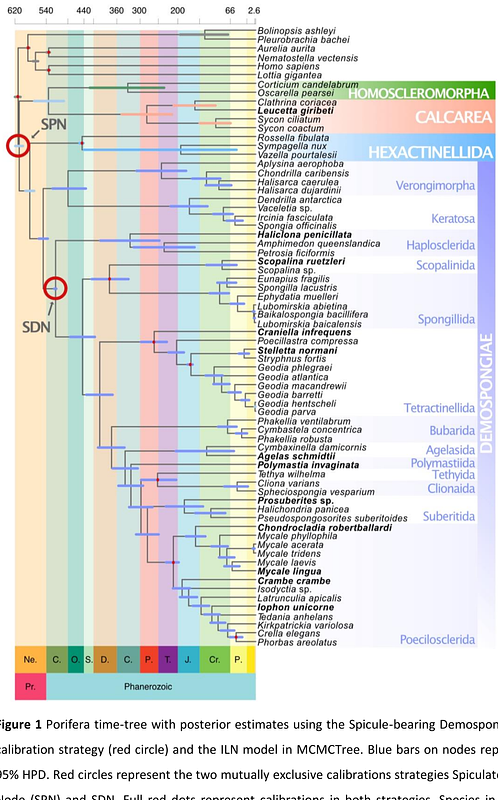Independent origins of spicules reconcile the evolutionary history of sponges

Independent origins of spicules reconcile the evolutionary history of sponges
Rossi, M. E.; Kenny, N. J.; Giacomelli, M.; Keating, J. N.; Alvarez-Carretero, S.; Schuster, A.; Cardenas, P.; Taboada, S.; Koutsouveli, V.; Donoghue, P.; Riesgo, A.; Pisani, D.
AbstractSponges (Porifera) are highly effective ecosystem engineers, playing a critical role in global biogeochemical processes, including the nitrogen, carbon, and silica cycles. Because of that, they have been closely linked to the evolution of Earth\'s environments. However, determining the evolutionary history of sponges has posed challenges. Molecular divergence times have pointed to a Tonian or Cryogenian origin for sponges. This contrasts with the oldest unequivocal fossil evidence for sponges, consisting of isolated siliceous spicules from the latest Ediacaran, resulting in a 150-million-mismatch with molecular clock estimates. This mismatch may arise because molecular clock estimates are inaccurate, the fossil record is incomplete, and/or the fossil record has been misinterpreted in the calibration of molecular clock analyses or some combination of the above. To resolve the deep evolutionary history of sponges we compiled an extensive phylogenomic dataset of sponges, revised fossil calibration evidence to derive a new phylogeny and timescale for sponge evolution, and investigated the evolutionary origin of the sponge spicules. Our results confirm that sponges include two main lineages: Silicea (Hexactinellida plus Demospongiae) and Calcarea plus Homoscleromorpha. Our molecular clock analyses identify an early Ediacaran estimate for the crown ancestor of sponges. Our study of spicule evolution shows that neither the last common sponge ancestor, nor the last common ancestors of Silicea and (Calcarea plus Homoscleromorpha) possessed siliceous spicules, which independently evolved four times in sponges: once in Hexactinellida, twice in Demospongiae, and once in Homoscleromorpha. Furthermore, diversification rate analyses demonstrate that the origin of spicules did not align with species radiations within the phylum. Our dating analyses substantially reduce the mismatch between molecular clock estimates for the antiquity of sponges and their fossil record. Our study of the evolutionary history of siliceous spicules reconciles the remaining difference as a consequence of crown-sponges primitively lacking siliceous spicules. As such we demonstrate the power of combining molecular and palaeontological approaches to establishing evolutionary timescales which together allow us to calibrate genome evolution to geological time and read evolutionary history within the gaps in the fossil record.


